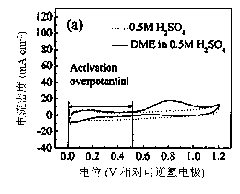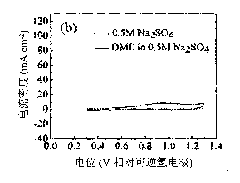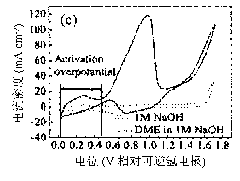Alkaline direct dimethyl ether fuel cell
A fuel cell and dimethyl ether technology, applied in fuel cells, solid electrolyte fuel cells, battery electrodes, etc., can solve the problems of poor reaction activity and poor oxygen electrochemical reduction activity, and achieve low production cost and high reaction activity , the effect of a wide range of sources
- Summary
- Abstract
- Description
- Claims
- Application Information
AI Technical Summary
Problems solved by technology
Method used
Image
Examples
Embodiment 1-1
[0040] Example 1-1: Preparation of polypyrrole-modified carbon-supported Pt-Ru catalyst
[0041] Disperse 10 grams of carbon black into water to form a suspension, the mass ratio of which is 1:15; add glacial acetic acid to adjust the pH value to 2.5, stir at room temperature for 10 minutes; add pyrrole and stir according to the mass ratio of carbon black to pyrrole of 1:0.05 5min, then add PtCl 2 and RuCl 2 0.6 g each; after stirring at room temperature for 3 h, add 0.05 g of H 2 o 2 ; After stirring for 3 hours at suffocation temperature, heat to 70°C; slowly add 300ml to a concentration of 0.1M L -1 After the reductant alkaline sodium borohydride solution, stirred vigorously for 30min, and cooled naturally; after washing and filtering with deionized water, vacuum drying at 70°C for 6h, and heat treatment at 300°C for 5h under an Ar inert atmosphere to obtain polypyrrole-modified carbon The Pt-Ru catalyst is supported, and the mass ratio of the Pt-Ru catalyst to the poly...
Embodiment 1-2
[0042] Example 1-2: Preparation of polypyrrole-modified carbon-supported Pt-Ru catalyst
[0043] Disperse 10 grams of carbon black into methanol to form a suspension, the mass ratio of which is 1:15; add hydrochloric acid to adjust the pH value to 3, stir at room temperature for 30 minutes; add pyrrole and stir according to the mass ratio of carbon black to pyrrole of 1:0.3 10min, then add PtCl 2 and RuCl 2 0.6 g each; after stirring at room temperature for 10 h, add 0.1 g of H 2 o 2 ; After stirring at room temperature for 10 hours, heat to 90°C; slowly add 300ml to a concentration of 0.1M L -1 The reductant alkaline sodium borohydride solution, stirred vigorously for 60min, and cooled naturally; after washing and filtering with deionized water, vacuum drying at 90°C for 12h, and then drying in N 2 Heat treatment at 600°C for 1 h under atmosphere to prepare polypyrrole-modified carbon-supported Pt-Ru catalyst, the mass ratio of Pt-Ru catalyst to polypyrrole-modified carbo...
Embodiment 1-3
[0044] Example 1-3: Preparation of polypyrrole-modified carbon-supported Pt-Ru catalyst
[0045] Disperse 10 grams of carbon black into methanol to form a suspension, the mass ratio of which is 1:15; add hydrochloric acid to adjust the pH value to 2.8, stir at room temperature for 20 minutes; add pyrrole and stir according to the mass ratio of carbon black to pyrrole of 1:0.2 20min, then add PtCl 2 and RuCl 2 0.6 g each; after stirring at room temperature for 6 h, add 0.08 g of H 2 o 2 ; After stirring at room temperature for 6 hours, heat to 80°C; slowly add 300ml to a concentration of 0.1M L -1 After the reductant alkaline sodium borohydride solution, stir vigorously for 50min, and cool naturally; wash and filter with deionized water, dry at 80°C for 9h in vacuum, and then store in N 2 Heat treatment at 500°C for 3 h under atmosphere to prepare polypyrrole-modified carbon-supported Pt-Ru catalyst, the mass ratio of Pt-Ru catalyst to polypyrrole-modified carbon support is...
PUM
 Login to View More
Login to View More Abstract
Description
Claims
Application Information
 Login to View More
Login to View More - R&D
- Intellectual Property
- Life Sciences
- Materials
- Tech Scout
- Unparalleled Data Quality
- Higher Quality Content
- 60% Fewer Hallucinations
Browse by: Latest US Patents, China's latest patents, Technical Efficacy Thesaurus, Application Domain, Technology Topic, Popular Technical Reports.
© 2025 PatSnap. All rights reserved.Legal|Privacy policy|Modern Slavery Act Transparency Statement|Sitemap|About US| Contact US: help@patsnap.com



